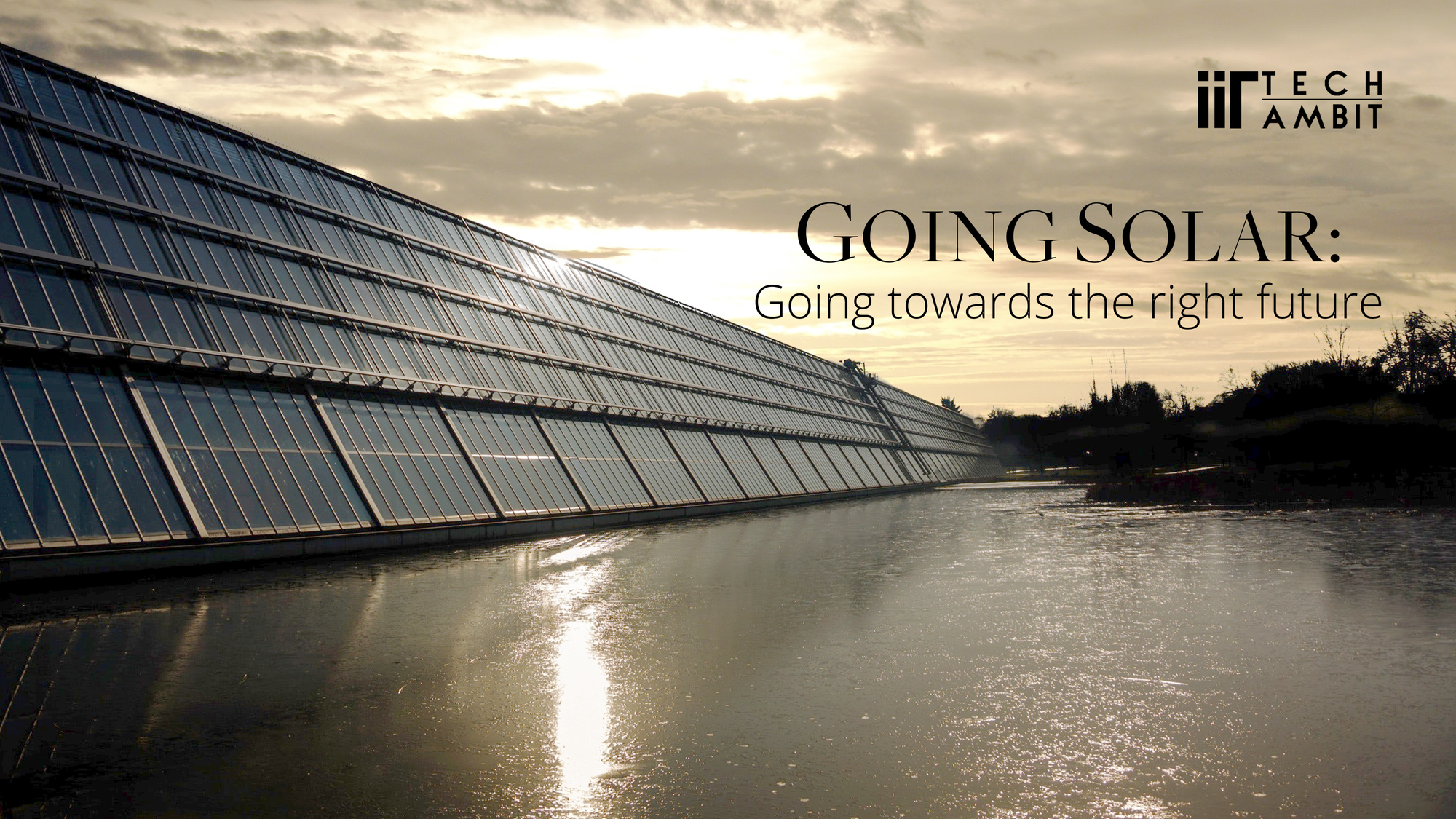Keeping in mind the huge negative environmental externalities caused by electricity generation from conventional sources of energy like fossil fuels, shifting to cleaner renewable sources of energy is the need of the hour.
As Gawdat Bahgat says in ‘Alternative Energy in the Middle-East’, “ The use of alternative energy is inevitable as fossil fuels are finite”. In particular,
India’s fossil fuel consumption has risen at an alarming rate, from 1 MWh per capita in 1965 to 5.5 MWh per capita in 2015. This being the case, the
day when we finally run out of these non-renewable sources of energy does not seem to be too far off. Also, the visible damage caused to the environment
by our indiscriminate consumption of fossil fuels can no longer be ignored. Every year human activity dumps roughly 8 billion metric tonnes of carbon into the atmosphere, 6.5 billion tonnes from fossil fuels and 1.5 billion from deforestation.
In addition, the poor quality of Indian coal with its high ash content (40%) has highly deteriorating environmental effects. Hence, it is only natural
that India has been making efforts to increase its total grid-connected renewable power generation capacity. Geographically, India is an ideal country for solar energy. We get 300 days of sunshine, our peak power demand is in the evening and not during daytime (driven by cooling requirements), and we have a seasonal peak in the summer. The fact that solar energy is renewable or unlimited,
environment-friendly and has low operating costs makes it a great alternative to fossil fuels. Having understood the immense future potential of solar energy, India has been making great strides in the field of solar power production and consumption.
How to go solar?
The technology which directly converts solar energy into electrical energy is called a solar photovoltaic cell. When radiation falls on a photovoltaic cell it absorbs the light depending on the bandgap of the cell, this absorbed photon creates electron-
hole pair which flows into the external circuit and hence generates the electric current. The amount of electrical energy generated depends on internal quantum efficiency and external quantum efficiency.
The first efficiency is the conversion of incident photons into the number of electron-hole pair while the second efficiency is indicating how many numbers of electrons excited from the semiconductor after being generated. The overall efficiency of the photovoltaic cell varies widely depending on the type.
There are two types of system configuration for solar photovoltaic namely Grid-tied and Stand Alone photovoltaic system, each one of them
having its own pros and cons as well as applications. In a Grid-tied photovoltaic system, light falls on a solar panel and is converted to DC power. This is fed to an inverter which converts this DC to AC power which will be matching phase, frequency and voltage as that of the grid. Off-grid or Stand- alone photovoltaic system includes the storage of the power that is generated when the demand is
less than what is generated. A component called charge controller is introduced in the system which is managing the charging process of the battery by regulating the electric current that is being generated by the solar panels. The working of the charge controller is divided into three modes: First is when the power generated is completely utilized by the AC load, the charge controller does not charge the battery and supplies direct power to the inverter which is then consumed by the loads. Second is when the AC load and DC load is working simultaneously, the charge controller will charge the battery and from there the current is fed
to the load. The third is during the night time or no sunlight condition the charged battery is being consumed up to its set low voltage value. Solar thermal power plants or STEs have a huge number of Grid-tied or stand-alone photovoltaic systems to convert solar energy into electricity.
Another new method of harnessing solar energy is Concentrated Photovoltaic Cells or CPVs. It employs sunlight concentrated onto photovoltaic surfaces for the purpose of electrical power production. Solar concentrators of all varieties
may be used, and these are often mounted on a solar tracker in order to keep the focal point upon the cell as the sun moves across the sky. CPV plants provide power by focusing solar radiation onto a photovoltaic module, which converts the
radiation directly to electricity. There are many technologies available to convert solar radiation into heat and finally to electricity using different energy conversion system. The technologies which convert solar to heat are the parabolic trough, Linear Fresnel, Heliostat tower and Dish Stirling engine.
Parabolic trough technology consists of a curved, mirrored trough which reflects the direct solar radiation onto a glass tube containing a fluid which is heat transfer medium running through the trough length, positioned at the focal line of the reflectors. Single-axis or daily tracking is introduced in this technology so that the heat transfer fluid is continuously heated up during the day-length. The temperature can rise up to 400°C. The hot liquid is passed through a series of heat exchangers to generate steam and drive a turbine.
Heliostat tower is formed by a field of heliostat which is a plane mirror spread over a large area such that they reflect the radiation at a central receiver where a heat transfer medium or heat storage medium is circulated. This medium achieves a
temperature of 600°C. This fluid is again used to generate steam which rotates the turbine and hence generates power.
Linear Fresnel technology consists of long flat reflectors which are reflecting radiation on one or more pipes containing heat transfer medium which has the same working as previous technologies. The main advantage of this technology is cost and space utilization being minimum; while the thermal storage technology for linear Fresnel is still under development.
Dish Stirling engine comprises a dish-shaped concentrator (like a satellite dish) that reflects solar radiation onto a receiver mounted at the focal point. The receiver is a Stirling engine coupled with a generator. Dish systems are said to be more
suitable for standalone, small power systems due to their modularity. However, such small power dishes can be installed in DNI rich area to obtain enough generation.
While the promise is large, there are some limitations
Solar energy has a number of advantages in India, the most important being that it is a renewable and hence unlimited source of energy. It is environment- friendly and does not release greenhouse gases into the atmosphere like fossil fuels. Solar panels have low operating costs and can be installed anywhere. It has diverse applications like heating, drying, cooking or electricity which is suitable for rural parts of the country. It does have its fair share of power production. The policy currently is purely for industrial rooftop projects. They do not have considerable benefits for a residential rooftop. State electricity utilities and distribution companies across India aren’t supportive as it could hurt their finances. As more and more commercial and industrial users, who bring the maximum revenues to state discoms take to solar power, the revenues of electricity generators and distributors would fall. The government is yet to come out with uniform policies around net metering that allows users to sell surplus power to electric utilities.
India - the cheapest solar energy producer
India is now the forerunner in producing solar power at the lowest cost globally and is far ahead of other nations in low average production costs, a report said. Beating countries like China, which usually is the cheapest manufacturer of everything, India has also left behind the US, UK, Canada and France among others. While the global average of installing utility-scale solar PV projects was $1210 for a kilowatt, the same was found to be as low as $793/kW in India in 2018, the report by the International Renewable Energy Agency (IRENA) said. India’s neighbour China also saw very competitive installation costs of $879/kW compared to the highest rate of $2,427 per kW in Canada. Among European countries, Italy saw very competitive installation costs for 2018 at $870/ kW. In recent years, the growth of solar energy in emerging markets has been phenomenal. India has already overtaken the US and has become the second-largest solar power market in the world (in terms of solar power installations). The country currently stands with ~25 GW of grid-connected solar power capacity as compared to 9 GW in 2015. Large scale solar installations in India account for 87 per cent solar capacity while rooftop sector is all set to pick up. Last year, solar accounted for nearly 53 per cent of new energy capacity additions in the country.
Conclusion
Given the current rates of global warming and the alarming rate at which our environment is deteriorating, adopting cleaner sources of energy like solar energy as a large-scale power production method is imperative. Besides the environmental benefits it will bring, solar energy development in India can spur regional economic development. India’s solar market could be worth billions of
dollars over the next decade - India’s solar potential is real enough, and the support environment is improving fast enough, to forecast a $6 billion to $7 billion capital-equipment market and close to $4 billion in annual revenues for grid-connected solar generators over the next decade. The secure electric supply it will provide can help to foster domestic industrial development. To conclude with
the words of Bjork, “Solar power, wind power, the way forward is to collaborate with nature -- it’s the only way we are going to get to the other end of the
21st century.”


